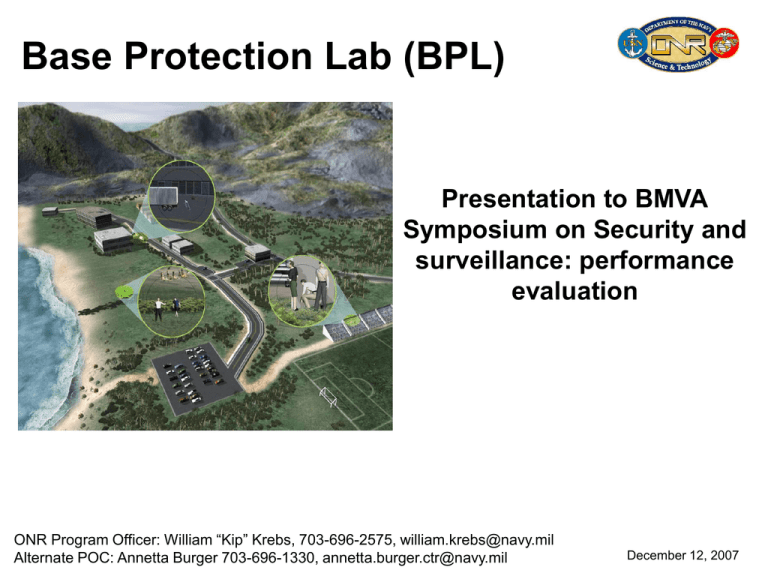PBPL HW PDR 19Dec2006
advertisement

Base Protection Lab (BPL) Presentation to BMVA Symposium on Security and surveillance: performance evaluation ONR Program Officer: William “Kip” Krebs, 703-696-2575, william.krebs@navy.mil Alternate POC: Annetta Burger 703-696-1330, annetta.burger.ctr@navy.mil December 12, 2007 Objectives • Conduct basic research to provide more open public access to recreational and other non-restricted facilities on military bases and to improve the overall base safety and security utilizing advanced video and signal based surveillance. • Create test bed in Hawaii to evaluate whether novel sensors (video cameras, radio frequency identification, seismic, LIDAR, microwave, and infrared sensors) in combination with behavior analysis software can identify patterns of behavior. Page 2 PMRF BPL System Diagram PMRF Base Protection Laboratory (PBPL) Data Collection (Integrated Sensor Systems) RFID MW / IR Lidar Seismic Video Textual Others Alert Delivery & Situation Data Development Platform Sensor Data Links (Wireless) Sensor Data Processing Data Storage & Archiving Simulation & Playback Behavioral Analysis Middleware Remote Users and Developers: – SAIC Kauai – SAIC Maui – SAIC Arlington – UH Manoa – Novasol Oahu – Object Video – MHPCC Maui – Others Firewall Internet External (Wide Area) Network Base Security Data Fusion & Tracking - Automated Behavior Analysis (ABA) - Statistical Anomaly Detection (SAD) - Agent Based Modeling (ABM) Alert Generation Production System – Data Analysis and Management Page 3 Current BPL Sensor Configuration 22°00’51.66”N 159°46’56.28”W • Outdoor Test Bed – 4.5km by 1km area – Linked by wireless communications • Open Architecture • Hardware Configuration – Mobile sensors enable optimum sensor coverage for data collection exercises • Software Configuration – modular, flexible and reusable – Object-oriented software – Based on Java Jini architecture – Communication through a “blackboard” Page 4 Sensors RFID System – UltraWideBand 2 LIDAR motion trackers 5 License Plate Readers 8 Low Light Cameras 4 Video Cameras Seismic Array (2000 feet) 2 MW/IR Fence Posts (500 feet fence) Page 5 Data Collection • Data Collection – Scripted Scenarios for Abnormal Activity • 4 Days data of confederates – Normal Data • 2 Days data of base personnel and recreational visitors • Sensor Collection Results – 12 video cameras with advanced video analytics software • detected and tracked objects of interest without problems – LIDAR – converted for intrusion detection and alarm sensor • Detected and provided accurate alerts – Microwave and Infrared Detection Fences • 100% detection and 0% false alarms for motion detection – RFID • Limited coverage to be improved with tuning antennas and replacing fixed sensors with mobile units – Seismic • No data available due to compatibility issues • Sensors should be available Jan08 Page 6 Proposed RFID Coverage 2D coverage (coordinates) Seen by three or more receivers Provides (x, y) with 3m or better accuracy 1D coverage (a point between two sensors) Seen by two receivers Provides a point (xΣ , yΣ) on a line between the two sensors. 0D coverage (presence in an area) Seen by one receiver Provides the coordinates of the sensor (xS , yS) that sees the entity No detection (no information) Seen by none of the receivers Page 7 RFID Track Page 8 Video Tracks Page 9 LIDAR Sensor 1000 feet Page 10 LIDAR Tracks map overlay System Administrator Display - pedestrian and vehicle traffic Page 11 Challenges • Develop a reliable, plug-play, robust test bed to meet researcher requirements. • Develop common standard data sets that vary in difficulty that can be used to assess algorithm performance. • Develop valid and reliable metrics to evaluate and compare behavioral algorithm performance. Page 12 Future Plans • Create common data sets and metrics. • Distribute data sets to research community to test whether behavioral algorithms can detect “normal” and “anomalous” behavior for the prediction of threats and advance warning using a variety of sensors. • Test and evaluate sensor options to optimize early detection of threat behavior and reduce security manpower requirements. Page 13






